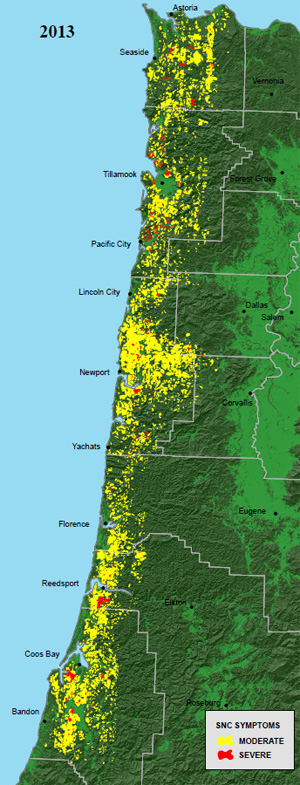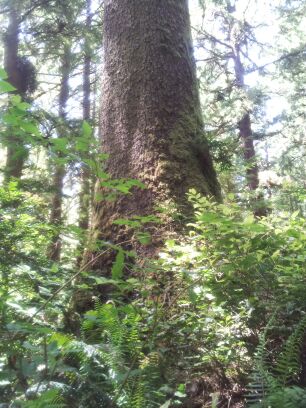It was quite a few years ago now, but an editorial in the Portland Oregonian came across as a tout-sheet for the conversion of cut-over timberlands to real estate holdings (Absence makes the heart grow fonder, Jan 2nd, 2010). It only served to drive home the words of philosopher George Santayana:
Those who cannot remember the past are condemned to repeat it.
The entire premise was underlain by a set of faulty assumptions that contradict much of what the article was trying to sell.
Let’s start with some ecological reality that rarely sees the light of day. Eastern Oregon
has suffered dramatically from the absurd notion that industrial forestry of the type practiced in Western Oregon was ever marginally viable in the dry forests of the interior. These two ecologically distinct parts of the state were for decades treated as one and the same for the purposes of projecting timber harvest, when nothing could have been further from the truth.
That’s something even new Oregonians understand intuitively. You can see it with your eyes if you bother to look. The editorial board, as one egregious example, makes no mention of the stark differences in climate and precipitation that drive forest growth. It’s a fact that industrial forestry may not even work on the West side. Chris Maser, Jim Trappe and their co-workers hypothesized long ago that continuously cropped forestlands are prone to failure because they eliminate the carryover components – the elements necessary for the re-generation of forest stands.
We certainly have enough evidence to state conclusively that it doesn’t work at all in the dry montane forests of the interior West. That’s an important story that The Oregonian has never even bothered to cover, yet that narrative challenge needs to be taken up by everyone in the state who claims care about the future of its forests.
What it means is this: none of the management plans for cutting hundreds of millions of board feet per year in Eastern Oregon were remotely sustainable. Public and private foresters, who logged the fire-resistant old-growth Ponderosa pines and replaced them with what they thought would be fast growing fir, were badly fooled. The resulting stands of sapling-choked forest have been magnets for insects, disease and fire.
Increased susceptibility to these agents has been couched in the gobbledygook of forest health. The reality is much simpler. These “problems” are a manifestation of the natural
thinning processes inherent in heavily over-stocked and, in this case, poorly managed stands. It’s what these forests undergo in re-establishing themselves. The mature trees that are the result of this thinning action from these agents, and that are the best adapted to resist them once they’ve fully developed, were cut down and hauled away. Sustainable timber harvesting would have identified these relationships as part of the information gathering process. Either willfully, or because of blind ignorance, that didn’t happen. That isn’t much of a business model, certainly not one with any staying power.
The yield increases never occurred and everyone now admits that Ponderosa is best suited to drier sites. The cost of managing stands to grow pine back should have been paid up front as part of the price of the timber that was sold off at what were bargain-basement prices. It has instead fallen to taxpayers, or in the case of private forests, remedied by selling off the land, what’s left of the trees, or both.
The public, having never been given a realistic price for its timber, is now asked to foot the bill for, at minimum, a hundred years of management, and that’s very optimistic. Short-rotation cropping has proved to be an abject failure. Moreover the seed-stock necessary to generate the best possible forest on a given site – from the cones on the trees that were originally there – have been carted off to the mills. There is no getting back those millennia of evolutionary benefits. The research that describes all of this is well documented.
As for the timber market, it became part of a much broader collapse that has little to do with environmentalism, and everything to do with technology in the 1980s, and then greed and gullibility from the 1990s right into the housing collapse of the 2000s.
The ecological part, the removal of the older forest trees, wasn’t even the biggest factor in the loss of jobs during those decades. That prize goes to increased automation and to the development of an unsustainable housing market built to feed bogus investment schemes, not to meet the needs of real people. The 1980’s saw the cutting of 40% of all the trees that had ever been logged on National Forests but mill jobs continued to disappear thanks to machinery. Then in the 1990s, Wall Street decided to create investments that derived their value from thousands of bundled home loan payments. That fed multi-million dollar bonuses for the suits and made a lot of IRAs look good, but it wasn’t sustainable either.
The skids were greased for the collapse in the last days of the 1990s, when regulation of these derivatives was prohibited in a 200-page amendment slipped into an appropriations bill by Phil Gramm. The resulting frenzy of greed-driven speculation drove home prices to levels never seen till then. As one example, Californians were getting loans for thirteen times their annual income when good real estate professionals use a value of 3 times income to decide whether a buyer can afford a property. That ended and the housing market there collapsed eventually leading to a four and a half year supply unsold. With it went the demand for lumber.
As a long-time reader of the Oregonian, I was just as disappointed by the historical lobotomy the paper seems to have undergone. The forests of the interior West have been subjected to wave after wave of collapse and consolidation. The history of logging in this part of the world is filled with this sort of boom and bust cycle. It’s why we need a diverse economy.
The newspaper’s lack of acquaintance with that boom and bust history is not even the most egregious problem with the editorial. That prize goes to the absurd notion that the public would ever have been given a say on private holdings. Forestland owners are doing what rational actors usually do with their investments, they’re maximizing them. That may mean liquidating the timber when the price is right, and if it can best be done by growing a crop of houses that will be the plan.
Imbuing the environmental movement with god-like powers – while giving the derivatives-crazed notions of Wall Street and the financial shenanigans of it’s acolytes in the timber industry and the larger world of hedge investing a pass – is willful deceit and a failure of journalistic competence. Real-estate investment trusts are just the final chapter in the gradual removal of the public from any say about the health of the forests lands the state was endowed with, both on the wet side and the dry side. That’s what happened, that’s the system that was built. That’s the one any reliable news source would discuss.






